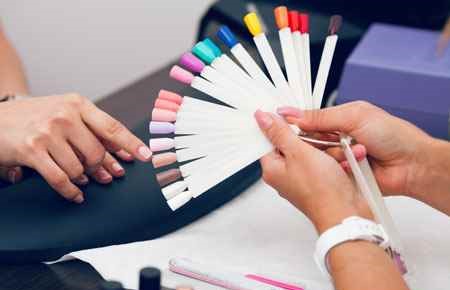
Manicurist and Pedicurist
Summary
Manicurists and pedicurists clean, shape, and beautify fingernails and toenails.
What they do
Manicurists and pedicurists typically do the following:
- Discuss nail treatments and services available
- Remove nail polish
- Clean, trim, and file nails
- Reduce calluses and rough skin
- Massage and moisturize hands (for a manicure) and feet (for a pedicure)
- Polish or buff nails
- Advise clients about nail and skin care for hands and feet
- Promote and sell nail and skin care products
- Clean and disinfect their work area and tools
Manicurists and pedicurists work exclusively on the hands and feet, providing treatments to groom fingernails and toenails. A typical treatment involves soaking the clients’ hands or feet to soften the skin in order to remove dead skin cells. Manicurists and pedicurists apply lotion to the hands and feet to moisturize the skin. They also may shape and apply polish to artificial fingernails.
Manicurists and pedicurists use a variety of tools, including nail clippers, nail files, and specialized cuticle tools. They must be focused while they perform their duties, because most of the tools they use are sharp. Keeping their tools clean and sanitary is important.
Some manicurists and pedicurists operate their own nail salon, which requires performing business tasks such as keeping inventory records and ordering supplies. They also hire and supervise workers and sell nail care products, such as nail polish and hand or foot cream. A small but growing number of workers make house calls. Mobile manicure and pedicure services are popular because clients consider them convenient.
Work Environment
Manicurists and pedicurists usually work in a nail salon, spa, or hair salon. The job involves a lot of sitting. Manicurists and pedicurists who provide mobile services may travel to their clients’ locations.
Manicurists and pedicurists use chemicals when working on fingernails and toenails, so they often wear protective clothing, including protective gloves and masks.
How to become a Manicurist and Pedicurist
Manicurists and pedicurists must complete a state-approved cosmetology or nail technician program and then pass a state exam for licensure, which all states except Connecticut require.
Manicurists and pedicurists must complete a state-approved cosmetology or nail technician program. Currently, there are hundreds of programs nationwide.
State licensing requirements vary. However, applicants need to be at least 16 years old and have a high school diploma or the equivalent. After completing a state-approved cosmetology or nail technician program, manicurists and pedicurists must take a written exam and a practical exam to get a license through their state board. Mobile manicure and pedicure services require a separate license.
The National–Interstate Council of State Boards of Cosmetology provides information on state examinations for licensing, with sample questions. The Professional Beauty Association and the American Association of Cosmetology Schools also provide information on state examinations, as well as offering other professional links.
Pay
The median hourly wage for manicurists and pedicurists was $12.39 in May 2019. The median wage is the wage at which half the workers in an occupation earned more than that amount and half earned less. The lowest 10 percent earned less than $9.73, and the highest 10 percent earned more than $17.66.
Job Outlook
Employment of manicurists and pedicurists is projected to grow 19 percent from 2019 to 2029, much faster than the average for all occupations.
The projected increase in employment reflects demand for new types of nail services, such as mini-sessions (quick manicures at a low cost) and mobile manicures and pedicures (nail services offered outside of the salon).
Similar Job Titles
Manicurist, Nail Technician, Pedicurist
Related Occupations
Massage Therapist, Barber, Hairdresser/Hairstylist/Cosmetologist, Shampooers, Skincare Specialist
More Information
The trade associations listed below represent organizations made up of people (members) who work and promote advancement in the field. Members are very interested in telling others about their work and about careers in those areas. As well, trade associations provide opportunities for organizational networking and learning more about the field’s trends and directions.
Magazines and Publications
Manicurists and pedicurists work on the hands and feet, grooming fingernails and toenails. They explain services and options available to customers, then offer a treatment— usually starting by soaking the clients’ hands or feet, reducing calluses, and applying lotion to moisturize the skin. The final step is to trim and file nails and apply polish, or artificial fingernails. Repeat business is critical in this field, so customer satisfaction is key. Good listening and interpersonal skills are helpful, along with creativity and precision to create well-finished nails that appeal to each customer. Using sharp tools requires care and a steady hand. Some manicurists and pedicurists operate their own nail salon business. They manage employees, keep inventory, and order supplies. A small, but growing, number of workers make house calls. Manicurists and pedicurists usually work in a nail salon, spa, or hair salon. The job involves a lot of sitting. Because of fumes and toxic exposure from nail polish and other chemicals, they often wear gloves and masks. Although most manicurists and pedicurists work full time including weekends and evenings, many have variable schedules and work part time. Longer work days are typical for those who are self-employed. Manicurists and pedicurists must complete a state-approved cosmetology or nail technician program and then pass a state exam for licensure.
Content retrieved from: US Bureau of Labor Statistics-OOH www.bls.gov/ooh,
CareerOneStop www.careeronestop.org, O*Net Online www.onetonline.org
